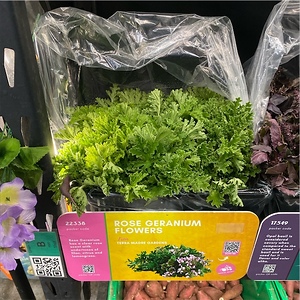


Rose Geranium Flowers
Estimated Inventory, bunch : 0
Description/Taste
Rose Geraniums are small edible flowers that grow on evergreen shrubs. These shrubs average about 1 to 1.2 meters tall and their bushy branches spread 1 to 1.5 meters wide. The branches feature deeply furled leaves covered with a velvety layer of fine hairs. Above these leaves, the Rose Geranium flowers bloom in hues of pink and lavender with deep purple veins. Clustered in umbels, these flowers are typically five-petaled and measure about 4 centimeters long. The stems, leaves, and flowers of the Rose Geranium plant are all fragrant, particularly when bruised. They have a distinct rose scent with undertones of lilac, citrus, and lemongrass.
Seasons/Availability
Rose Geranium flowers are available from summer to winter.
Current Facts
Rose Geranium flowers belong to the Geraniaceae family and are botanically classified as Pelargonium graveolens. The word graveolens means highly scented in Latin, indicative of the plants' fragrant nature. Most of their scent comes from oils in the leaves, but oil can also be distilled from the flowers and stalks. Rose Geranium plants are entirely edible and used in culinary, medicinal, and herbal applications. Their leaves are incorporated into cosmetics, jellies, teas, and potpourris. Rose Geraniums are particularly popular for skin and aromatherapy products because of their ability to refresh skin and calm the nerves. There are over 700 species of Geranium, including other colorful floral varieties like Sticky Geranium, Meadow Cranesbill, Herb Robert, Geranium Oreganum, and Armenian Cranesbill.
Nutritional Value
Rose Geranium flowers are rich in antioxidants and their extracts help protect the skin from oxidative stress caused by factors like pollution and UV radiation. Their anti-inflammatory and antibacterial properties make them effective for treating skin conditions like acne and rosacea, while also aiding in wound healing. In aromatherapy, Rose Geranium's calming scent is believed to alleviate stress and anxiety, and can also serve as an appetite suppressant. The essential oils from the plant are hydrating and thought to promote smoother, more elastic skin. Rose Geraniums have been traditionally used as diuretics, antiseptics, and astringents. They may be effective in treating infections, soothing calluses, and softening dry skin. The leaves can also be used in teas for digestive issues or in baths to soothe rashes and skin irritations.
Applications
Both the leaves and flowers of Rose Geraniums are best used in sweet applications. The flowers offer a delicate texture and mild flavor that blends well with jellies, jams, ice cream, syrups, icing, and liqueur. Rose Geranium flowers can be mixed with plain sugar and infused for a few weeks to then be added to desserts like cake, biscuits, muffins, cookies, and crumbles. When baking a cake, the tin should be lined with the leaves and flowers before pouring in the batter to impart a floral scent as it bakes. Rose Geranium flowers are often incorporated into beverages like sweet herbal tea, lassi, flavored waters, and cocktails. They are complemented by ingredients like rhubarb, lemon, lime, grapefruit, plum, blueberry, blackberry, strawberry, cardamom, custard, buttermilk, whipped cream, almond, and vanilla. When not used fresh, Rose Geranium flowers can be dried by baking them at 93 degrees Celcius for 5 to 8 minutes. Once dried, they may be stored in an airtight container for several months.
Ethnic/Cultural Info
Rose Geraniums flowers are associated with many gods and goddesses, including Aphrodite, Eros, Cernunnos, and Gaia, representing ideals of love, fertility, and mother Earth. According to a Muslim legend, the first Geranium blossomed when the Prophet Muhammad draped his shirt on a plant to dry in the sun. Upon his return, the shirt had grown Geranium flowers all over it, which was said to ward off snakes. It’s believed that downward-facing Germanium blossoms signify the grower of the flower is holding on to the past.
Geography/History
Rose Geranium flowers are native to the Cape of Good Hope in South Africa. They have been naturalized in Morroco, Madagascar, Egypt, China, and the island of La Réunion off the eastern coast of Africa. They are both heat and drought-tolerant, requiring full sun and thriving in sandy soils with low moisture levels. Rose Geraniums may grow in temperate climates around the world and can be found in the wild in sand dues and shrublands along the cape of South Africa. These flowers do well in home gardens where they are grown in containers, hanging baskets, or pruned as a hedge. Rose Geranium flowers became popular in the 1700s when they were used as a replacement for the more expensive rose attar in perfumes. Rose Geranium farms were then developed throughout Kenya. The oil derived from this plant continues to be popular, primarily in Egypt, China, and India. In other parts of the world, Rose Geranium flowers are most likely to be purchased from specialty stores or bought from seeds to be sown in home gardens.
Recipe Ideas
Recipes that include Rose Geranium Flowers. One








